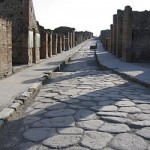An in depth look at the World’s First paved roads, which by AD 117 had grown to over 80,000 KM and spidered all throughout Europe.
Three Types of Road
In planning for accommodating the various types of traffic and amount of effort involved the Roman Empire devised three types of roads to be used. One: simply leveled earth, the other: gravel paths with pavers on top; and lastly: deeply excavated roads (five layers) with pavers and cement on top.
Via terrena
These roads required no construction or preparation, they were merely paths in the earth caused by continous traffic by foot and carriage. They of course had the problem of becoming pure mud should there be sufficient rain or snow.
Via glareata
The first actual type of constructed road by the Romans, the Via Glareta consisted of an earthed path (about 6 inches) filled in with coarse gravel and then either a finer gravel on top of that or paving stones. (Comparable somewhat to the American ‘macadam’ which was ‘invented’ so to speak in the early 1800s).
Via munita
 This is the classic Roman road as we know it and is closest to our modern day paver/paving stone pathways. The Via Munita was an intricate set up, with seven component parts, five of them be actual layers in the road itself, and the remaining two are for edging and shoring. Although the width varied it was typically two meters and it would arch and reach a slight apex in the center. This served to prevent the road from retaining water and pooling.
This is the classic Roman road as we know it and is closest to our modern day paver/paving stone pathways. The Via Munita was an intricate set up, with seven component parts, five of them be actual layers in the road itself, and the remaining two are for edging and shoring. Although the width varied it was typically two meters and it would arch and reach a slight apex in the center. This served to prevent the road from retaining water and pooling.
Two Thousand Years Later
It is humorous and rather unimaginable that nearly two thousand years after the development of this technology and its omnipresence throughout Europe, that you would still see cities without the slightest semblance of a road. Take for instance 1919 the Washington Richmond Road, 30 miles south of D.C. this major thoroughfare was just dirt and mud!

